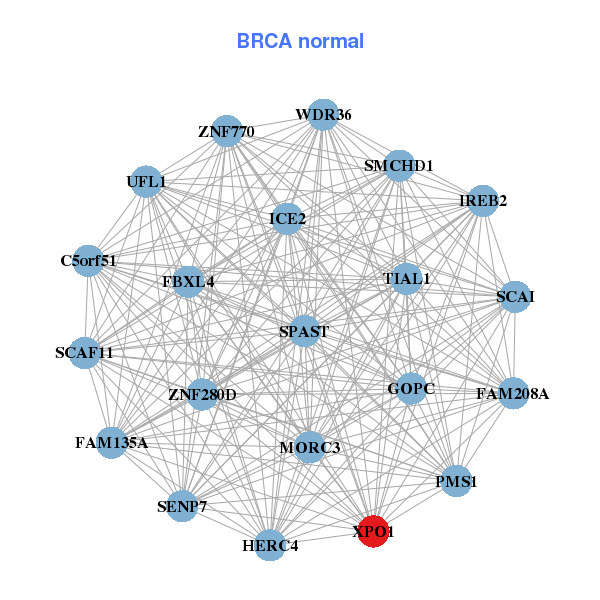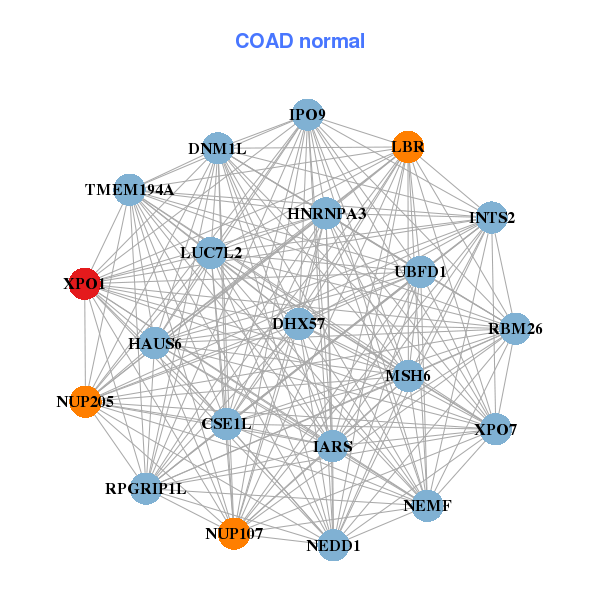|
|||||||||||||||||||||||||||||||||||||||||||||||||||||||||||||||||||||||||||||||||||||||||||||||||||||||||||||||||||||||||||||||||||||||||||||||||||||||||||||||||||||||||||||||||||||||||||||||||||||||||||||||||||||||||||||||||||||||||||||||||||||||||||||||||||||||||||||||||||||||||||||||||||||||||||||||||||||||||||||||||||||||||||||||||||||||||||||||
| |
| Phenotypic Information (metabolism pathway, cancer, disease, phenome) |
| |
| |
| Gene-Gene Network Information: Co-Expression Network, Interacting Genes & KEGG |
| |
|
| Gene Summary for XPO1 |
| Basic gene info. | Gene symbol | XPO1 |
| Gene name | exportin 1 | |
| Synonyms | CRM1|emb|exp1 | |
| Cytomap | UCSC genome browser: 2p15 | |
| Genomic location | chr2 :61705068-61765418 | |
| Type of gene | protein-coding | |
| RefGenes | NM_003400.3, | |
| Ensembl id | ENSG00000082898 | |
| Description | CRM1, yeast, homologchromosome region maintenance 1 homologchromosome region maintenance 1 protein homologexportin 1 (CRM1 homolog, yeast)exportin-1exportin-1 (required for chromosome region maintenance) | |
| Modification date | 20141222 | |
| dbXrefs | MIM : 602559 | |
| HGNC : HGNC | ||
| Ensembl : ENSG00000082898 | ||
| HPRD : 03975 | ||
| Vega : OTTHUMG00000152316 | ||
| Protein | UniProt: O14980 go to UniProt's Cross Reference DB Table | |
| Expression | CleanEX: HS_XPO1 | |
| BioGPS: 7514 | ||
| Gene Expression Atlas: ENSG00000082898 | ||
| The Human Protein Atlas: ENSG00000082898 | ||
| Pathway | NCI Pathway Interaction Database: XPO1 | |
| KEGG: XPO1 | ||
| REACTOME: XPO1 | ||
| ConsensusPathDB | ||
| Pathway Commons: XPO1 | ||
| Metabolism | MetaCyc: XPO1 | |
| HUMANCyc: XPO1 | ||
| Regulation | Ensembl's Regulation: ENSG00000082898 | |
| miRBase: chr2 :61,705,068-61,765,418 | ||
| TargetScan: NM_003400 | ||
| cisRED: ENSG00000082898 | ||
| Context | iHOP: XPO1 | |
| cancer metabolism search in PubMed: XPO1 | ||
| UCL Cancer Institute: XPO1 | ||
| Assigned class in ccmGDB | B - This gene belongs to cancer gene. | |
| Top |
| Phenotypic Information for XPO1(metabolism pathway, cancer, disease, phenome) |
| Cancer | CGAP: XPO1 |
| Familial Cancer Database: XPO1 | |
| * This gene is included in those cancer gene databases. |
|
|
|
|
|
| . | |||||||||||||||||||||||||||||||||||||||||||||||||||||||||||||||||||||||||||||||||||||||||||||||||||||||||||||||||||||||||||||||||||||||||||||||||||||||||||||||||||||||||||||||||||||||||||||||||||||||||||||||||||||||||||||||||||||||||||||||||||||||||||||||||||||||||||||||||||||||||||||||||||||||||||||||||||||||||||||||||||||||||||||||||||||||||
Oncogene 1 | Significant driver gene in CLL 6, | ||||||||||||||||||||||||||||||||||||||||||||||||||||||||||||||||||||||||||||||||||||||||||||||||||||||||||||||||||||||||||||||||||||||||||||||||||||||||||||||||||||||||||||||||||||||||||||||||||||||||||||||||||||||||||||||||||||||||||||||||||||||||||||||||||||||||||||||||||||||||||||||||||||||||||||||||||||||||||||||||||||||||||||||||||||||||||||||
| cf) number; DB name 1 Oncogene; http://nar.oxfordjournals.org/content/35/suppl_1/D721.long, 2 Tumor Suppressor gene; https://bioinfo.uth.edu/TSGene/, 3 Cancer Gene Census; http://www.nature.com/nrc/journal/v4/n3/abs/nrc1299.html, 4 CancerGenes; http://nar.oxfordjournals.org/content/35/suppl_1/D721.long, 5 Network of Cancer Gene; http://ncg.kcl.ac.uk/index.php, 6 http://www.nature.com/nature/journal/v505/n7484/full/nature12912.html, 7Therapeutic Vulnerabilities in Cancer; http://cbio.mskcc.org/cancergenomics/statius/ |
| REACTOME_METABOLISM_OF_MRNA REACTOME_METABOLISM_OF_RNA | |
| OMIM | 602559; gene. |
| Orphanet | |
| Disease | KEGG Disease: XPO1 |
| MedGen: XPO1 (Human Medical Genetics with Condition) | |
| ClinVar: XPO1 | |
| Phenotype | MGI: XPO1 (International Mouse Phenotyping Consortium) |
| PhenomicDB: XPO1 | |
| Mutations for XPO1 |
| * Under tables are showing count per each tissue to give us broad intuition about tissue specific mutation patterns.You can go to the detailed page for each mutation database's web site. |
| - Statistics for Tissue and Mutation type | Top |
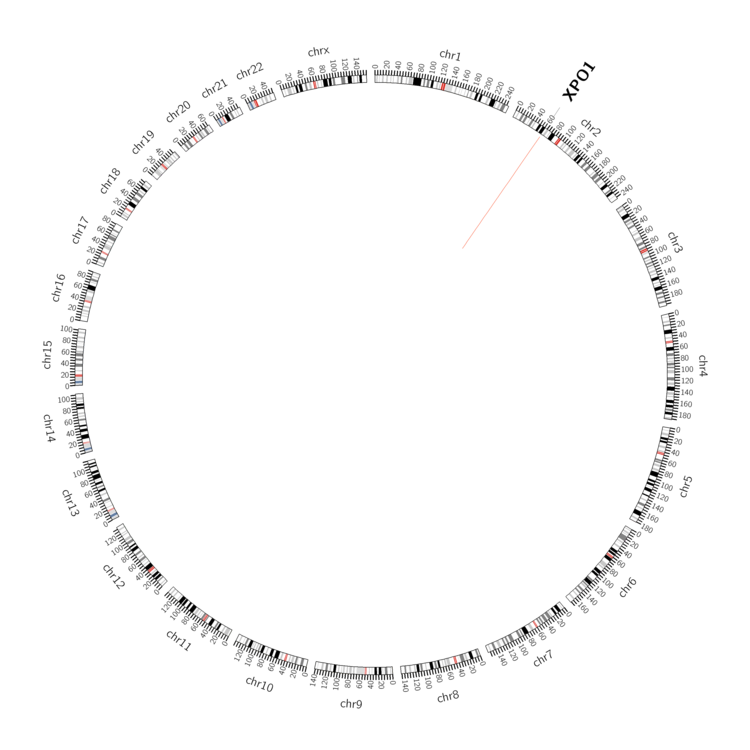 |
| - For Inter-chromosomal Variations |
| There's no inter-chromosomal structural variation. |
| - For Intra-chromosomal Variations |
| * Intra-chromosomal variantions includes 'intrachromosomal amplicon to amplicon', 'intrachromosomal amplicon to non-amplified dna', 'intrachromosomal deletion', 'intrachromosomal fold-back inversion', 'intrachromosomal inversion', 'intrachromosomal tandem duplication', 'Intrachromosomal unknown type', 'intrachromosomal with inverted orientation', 'intrachromosomal with non-inverted orientation'. |
 |
| Sample | Symbol_a | Chr_a | Start_a | End_a | Symbol_b | Chr_b | Start_b | End_b |
| haematopoietic_and_lymphoid_tissue | XPO1 | chr2 | 61726887 | 61726887 | XPO1 | chr2 | 61726887 | 61726887 |
| cf) Tissue number; Tissue name (1;Breast, 2;Central_nervous_system, 3;Haematopoietic_and_lymphoid_tissue, 4;Large_intestine, 5;Liver, 6;Lung, 7;Ovary, 8;Pancreas, 9;Prostate, 10;Skin, 11;Soft_tissue, 12;Upper_aerodigestive_tract) |
| * From mRNA Sanger sequences, Chitars2.0 arranged chimeric transcripts. This table shows XPO1 related fusion information. |
| ID | Head Gene | Tail Gene | Accession | Gene_a | qStart_a | qEnd_a | Chromosome_a | tStart_a | tEnd_a | Gene_a | qStart_a | qEnd_a | Chromosome_a | tStart_a | tEnd_a |
| AA559883 | XPO1 | 1 | 64 | 2 | 61724028 | 61724091 | XPO1 | 60 | 148 | 2 | 61722680 | 61724033 | |
| DB158037 | ZNF100 | 1 | 86 | 19 | 21913286 | 21913371 | XPO1 | 83 | 560 | 2 | 61749775 | 61764896 | |
| BG259252 | XPO1 | 15 | 112 | 2 | 61715331 | 61715746 | XPO1 | 110 | 729 | 2 | 61709608 | 61715358 | |
| BM462202 | XPO1 | 16 | 109 | 2 | 61705205 | 61705298 | XPO1 | 91 | 213 | 2 | 61705069 | 61705189 | |
| N53198 | XPO1 | 23 | 360 | 2 | 61715625 | 61715962 | TRAPPC9 | 354 | 381 | 8 | 141227840 | 141227867 | |
| DB198554 | XPO1 | 1 | 294 | 2 | 61713792 | 61714085 | XPO1 | 291 | 625 | 2 | 61715731 | 61716065 | |
| Top |
| Mutation type/ Tissue ID | brca | cns | cerv | endome | haematopo | kidn | Lintest | liver | lung | ns | ovary | pancre | prost | skin | stoma | thyro | urina | |||
| Total # sample | 1 | 1 | ||||||||||||||||||
| GAIN (# sample) | 1 | 1 | ||||||||||||||||||
| LOSS (# sample) |
| cf) Tissue ID; Tissue type (1; Breast, 2; Central_nervous_system, 3; Cervix, 4; Endometrium, 5; Haematopoietic_and_lymphoid_tissue, 6; Kidney, 7; Large_intestine, 8; Liver, 9; Lung, 10; NS, 11; Ovary, 12; Pancreas, 13; Prostate, 14; Skin, 15; Stomach, 16; Thyroid, 17; Urinary_tract) |
| Top |
|
 |
| Top |
| Stat. for Non-Synonymous SNVs (# total SNVs=109) | (# total SNVs=20) |
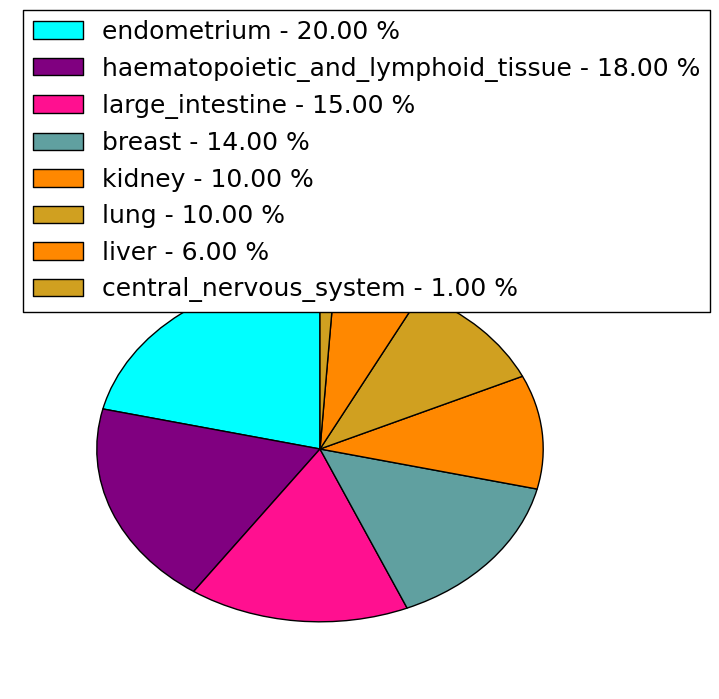 | 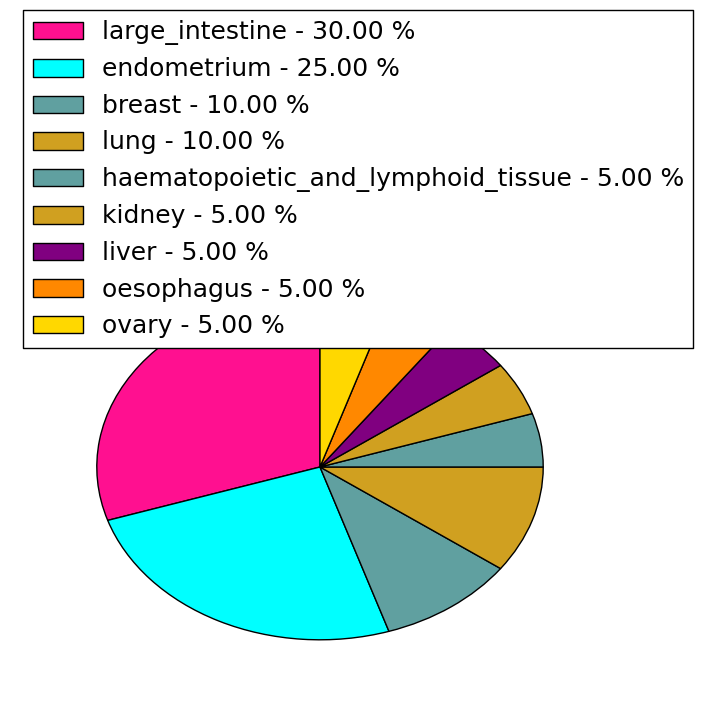 |
(# total SNVs=2) | (# total SNVs=0) |
 |
| Top |
| * When you move the cursor on each content, you can see more deailed mutation information on the Tooltip. Those are primary_site,primary_histology,mutation(aa),pubmedID. |
| GRCh37 position | Mutation(aa) | Unique sampleID count |
| chr2:61719472-61719472 | p.E571K | 20 |
| chr2:61715367-61715367 | p.R749Q | 6 |
| chr2:61715726-61715726 | p.N735Y | 4 |
| chr2:61719471-61719471 | p.E571V | 4 |
| chr2:61722723-61722723 | p.R305Q | 3 |
| chr2:61726051-61726051 | p.? | 3 |
| chr2:61719190-61719191 | p.I622fs*2 | 2 |
| chr2:61711203-61711203 | p.F849Y | 2 |
| chr2:61715853-61715853 | p.L692L | 2 |
| chr2:61712909-61712909 | p.I834M | 2 |
| Top |
|
 |
| Point Mutation/ Tissue ID | 1 | 2 | 3 | 4 | 5 | 6 | 7 | 8 | 9 | 10 | 11 | 12 | 13 | 14 | 15 | 16 | 17 | 18 | 19 | 20 |
| # sample | 4 | 5 | 1 | 13 | 4 | 8 | 1 | 7 | 2 | 1 | 4 | 5 | 18 | |||||||
| # mutation | 4 | 4 | 1 | 13 | 4 | 8 | 1 | 8 | 2 | 1 | 4 | 9 | 22 | |||||||
| nonsynonymous SNV | 3 | 3 | 1 | 8 | 3 | 8 | 1 | 6 | 2 | 2 | 5 | 17 | ||||||||
| synonymous SNV | 1 | 1 | 5 | 1 | 2 | 1 | 2 | 4 | 5 |
| cf) Tissue ID; Tissue type (1; BLCA[Bladder Urothelial Carcinoma], 2; BRCA[Breast invasive carcinoma], 3; CESC[Cervical squamous cell carcinoma and endocervical adenocarcinoma], 4; COAD[Colon adenocarcinoma], 5; GBM[Glioblastoma multiforme], 6; Glioma Low Grade, 7; HNSC[Head and Neck squamous cell carcinoma], 8; KICH[Kidney Chromophobe], 9; KIRC[Kidney renal clear cell carcinoma], 10; KIRP[Kidney renal papillary cell carcinoma], 11; LAML[Acute Myeloid Leukemia], 12; LUAD[Lung adenocarcinoma], 13; LUSC[Lung squamous cell carcinoma], 14; OV[Ovarian serous cystadenocarcinoma ], 15; PAAD[Pancreatic adenocarcinoma], 16; PRAD[Prostate adenocarcinoma], 17; SKCM[Skin Cutaneous Melanoma], 18:STAD[Stomach adenocarcinoma], 19:THCA[Thyroid carcinoma], 20:UCEC[Uterine Corpus Endometrial Carcinoma]) |
| Top |
| * We represented just top 10 SNVs. When you move the cursor on each content, you can see more deailed mutation information on the Tooltip. Those are primary_site, primary_histology, mutation(aa), pubmedID. |
| Genomic Position | Mutation(aa) | Unique sampleID count |
| chr2:61719472 | p.E571K | 6 |
| chr2:61715367 | p.R749Q | 4 |
| chr2:61712950 | p.Q821E | 2 |
| chr2:61709610 | p.R305Q | 2 |
| chr2:61722723 | p.S959S | 2 |
| chr2:61715794 | p.D64N | 1 |
| chr2:61724052 | p.A1010D | 1 |
| chr2:61706062 | p.D523A | 1 |
| chr2:61719576 | p.H352Q | 1 |
| chr2:61753558 | p.K54N | 1 |
| * Copy number data were extracted from TCGA using R package TCGA-Assembler. The URLs of all public data files on TCGA DCC data server were gathered on Jan-05-2015. Function ProcessCNAData in TCGA-Assembler package was used to obtain gene-level copy number value which is calculated as the average copy number of the genomic region of a gene. |
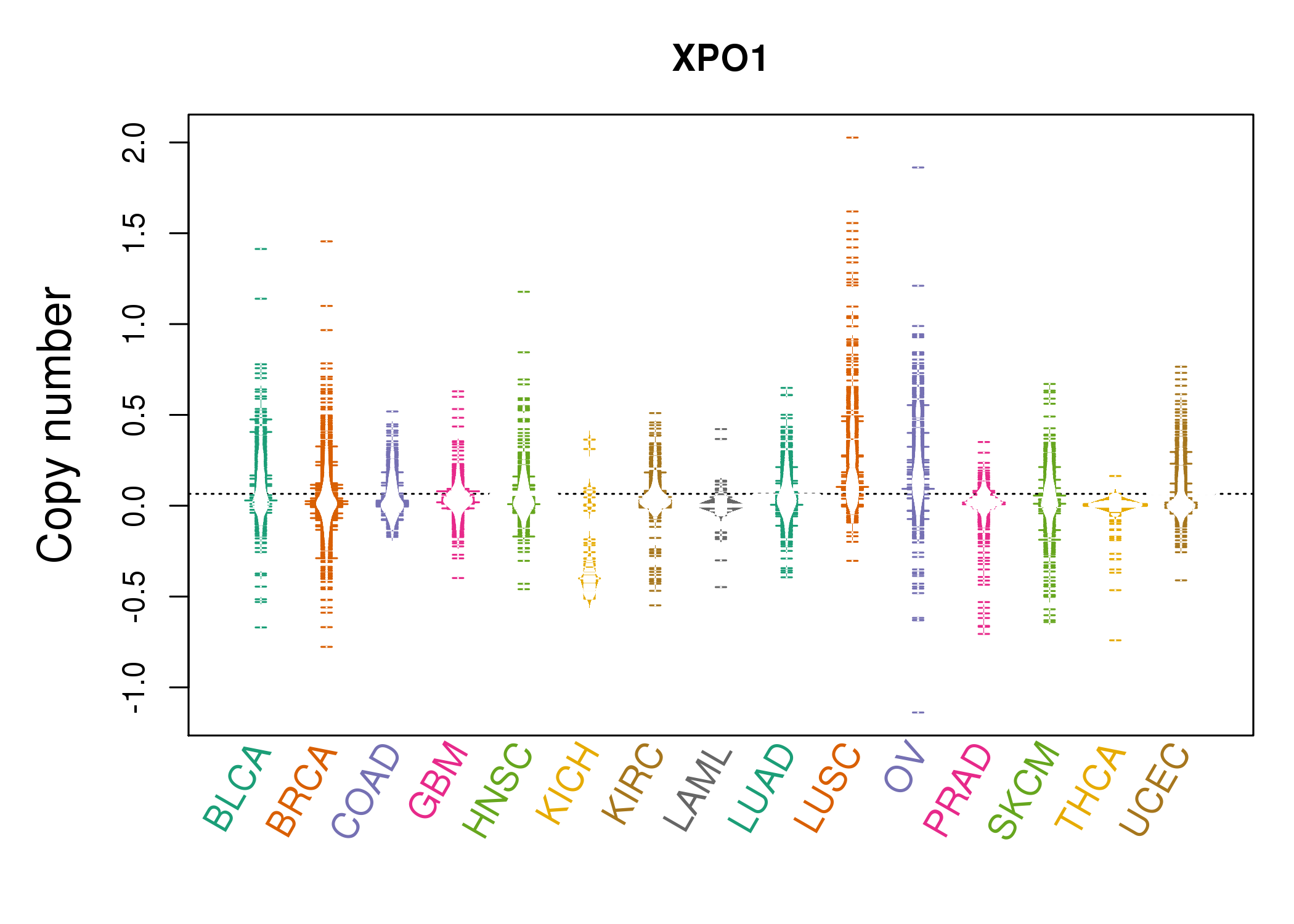 |
| cf) Tissue ID[Tissue type]: BLCA[Bladder Urothelial Carcinoma], BRCA[Breast invasive carcinoma], CESC[Cervical squamous cell carcinoma and endocervical adenocarcinoma], COAD[Colon adenocarcinoma], GBM[Glioblastoma multiforme], Glioma Low Grade, HNSC[Head and Neck squamous cell carcinoma], KICH[Kidney Chromophobe], KIRC[Kidney renal clear cell carcinoma], KIRP[Kidney renal papillary cell carcinoma], LAML[Acute Myeloid Leukemia], LUAD[Lung adenocarcinoma], LUSC[Lung squamous cell carcinoma], OV[Ovarian serous cystadenocarcinoma ], PAAD[Pancreatic adenocarcinoma], PRAD[Prostate adenocarcinoma], SKCM[Skin Cutaneous Melanoma], STAD[Stomach adenocarcinoma], THCA[Thyroid carcinoma], UCEC[Uterine Corpus Endometrial Carcinoma] |
| Top |
| Gene Expression for XPO1 |
| * CCLE gene expression data were extracted from CCLE_Expression_Entrez_2012-10-18.res: Gene-centric RMA-normalized mRNA expression data. |
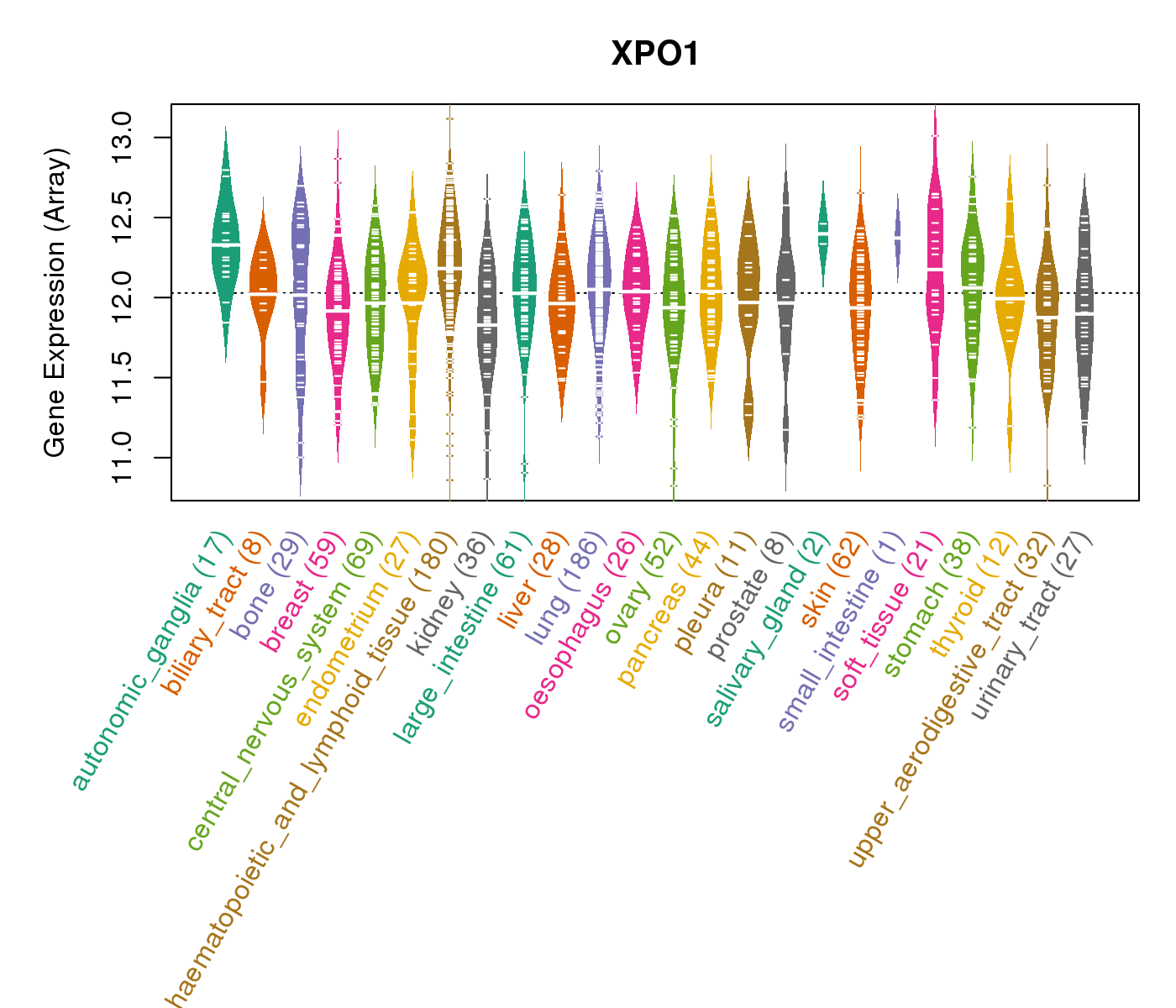 |
| * Normalized gene expression data of RNASeqV2 was extracted from TCGA using R package TCGA-Assembler. The URLs of all public data files on TCGA DCC data server were gathered at Jan-05-2015. Only eight cancer types have enough normal control samples for differential expression analysis. (t test, adjusted p<0.05 (using Benjamini-Hochberg FDR)) |
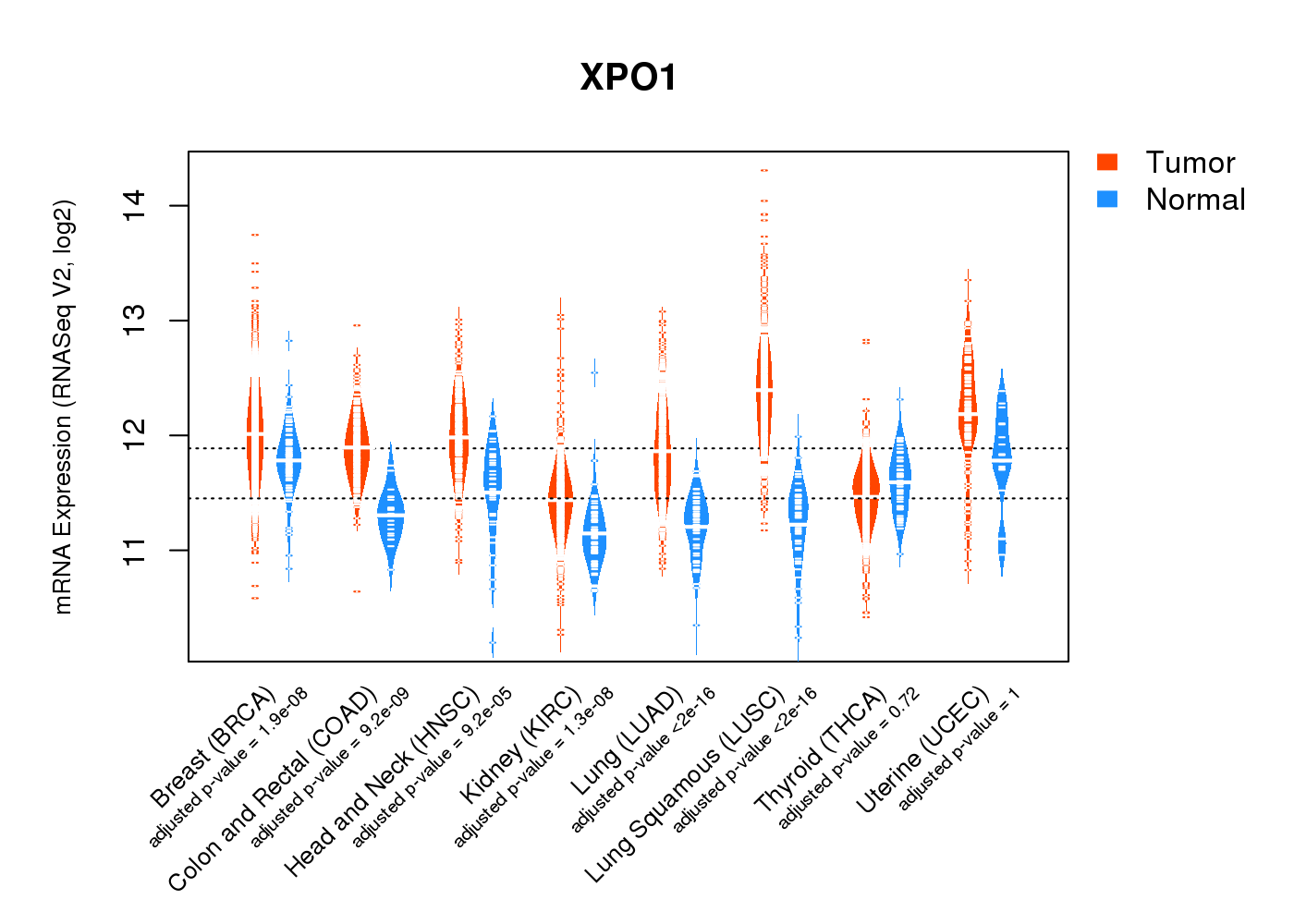 |
| Top |
| * This plots show the correlation between CNV and gene expression. |
: Open all plots for all cancer types
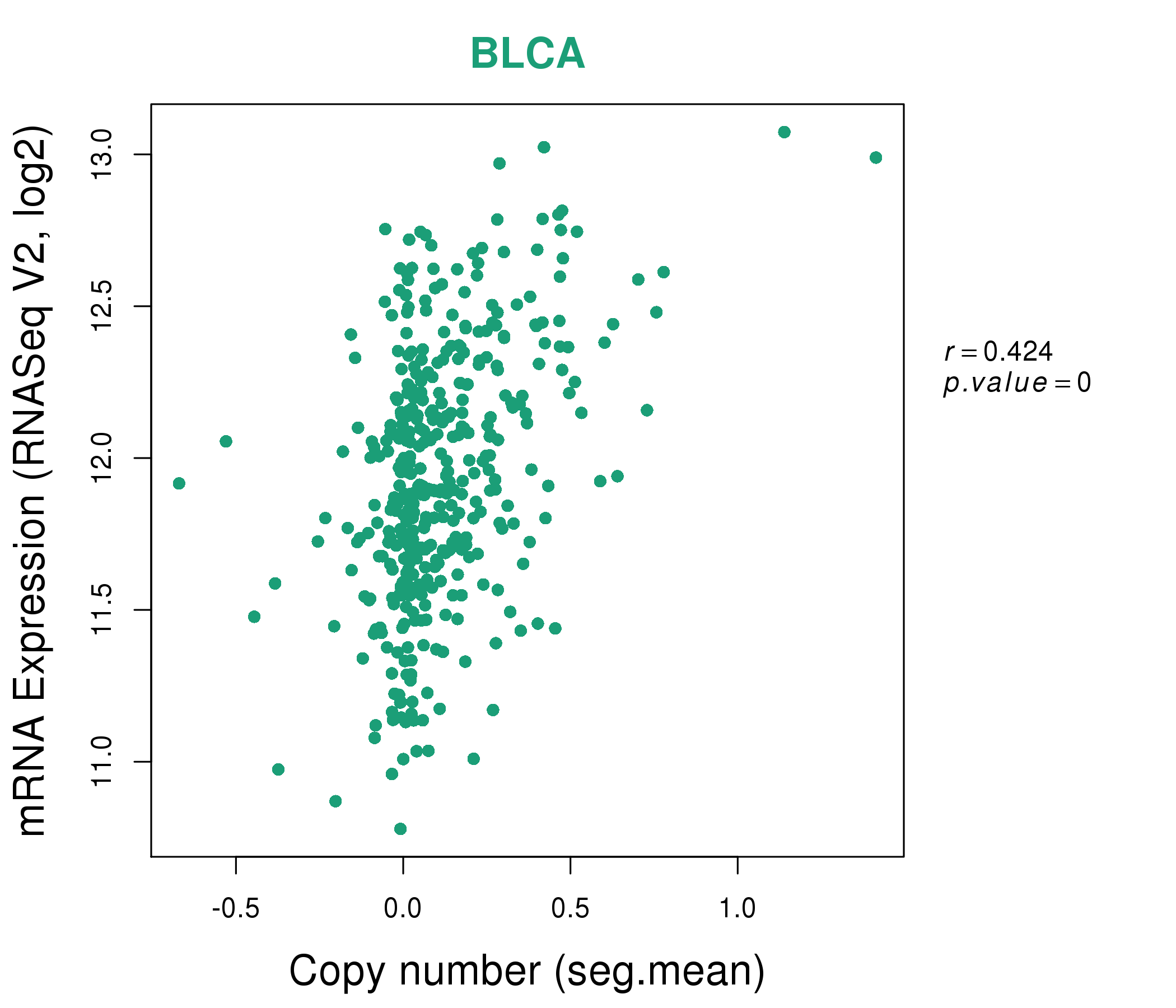 |
|
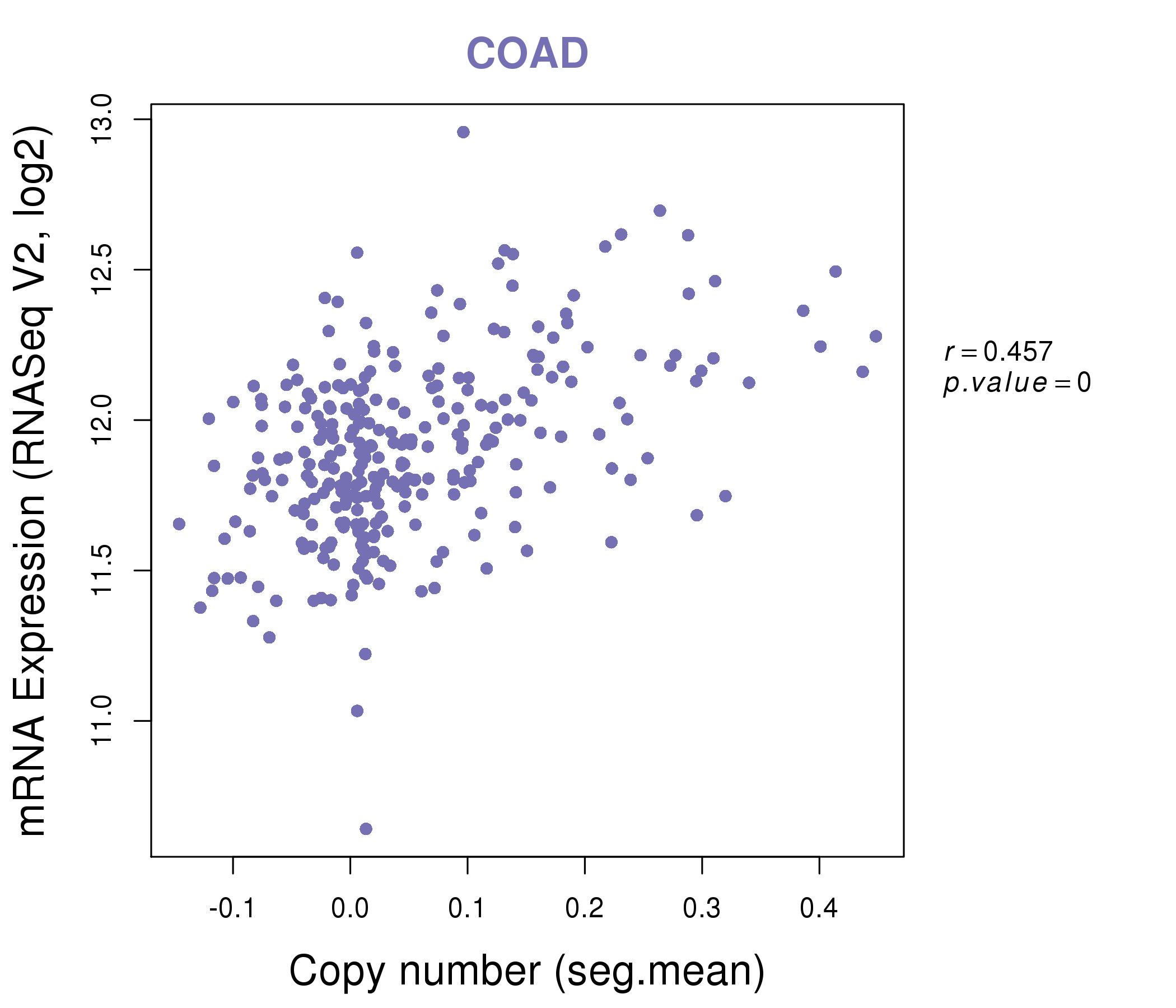 |
|
| Top |
| Gene-Gene Network Information |
| * Co-Expression network figures were drawn using R package igraph. Only the top 20 genes with the highest correlations were shown. Red circle: input gene, orange circle: cell metabolism gene, sky circle: other gene |
: Open all plots for all cancer types
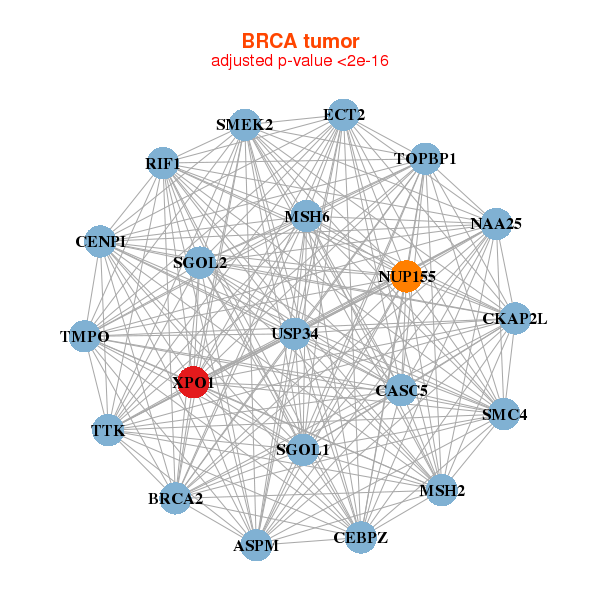 |
| ||||
| ASPM,BRCA2,CASC5,CEBPZ,CENPI,CKAP2L,ECT2, MSH2,MSH6,NAA25,NUP155,RIF1,SGOL1,SGOL2, SMC4,SMEK2,TMPO,TOPBP1,TTK,USP34,XPO1 | FAM208A,C5orf51,FAM135A,FBXL4,GOPC,HERC4,IREB2, UFL1,MORC3,ICE2,PMS1,SCAI,SENP7,SCAF11, SMCHD1,SPAST,TIAL1,WDR36,XPO1,ZNF280D,ZNF770 | ||||
 |
| ||||
| ATAD5,BUB1,CCDC138,CEBPZ,DDX18,DNA2,FANCI, FBXO5,KIAA1524,MSH2,NCAPH,PMS1,PNPT1,POLR2D, PRPF40A,SGOL2,TMEM194A,TOPBP1,WDR43,WDR75,XPO1 | CSE1L,DHX57,DNM1L,HAUS6,HNRNPA3,IARS,INTS2, IPO9,LBR,LUC7L2,MSH6,NEDD1,NUP107,NUP205, RBM26,RPGRIP1L,NEMF,TMEM194A,UBFD1,XPO1,XPO7 |
| * Co-Expression network figures were drawn using R package igraph. Only the top 20 genes with the highest correlations were shown. Red circle: input gene, orange circle: cell metabolism gene, sky circle: other gene |
: Open all plots for all cancer types
| Top |
: Open all interacting genes' information including KEGG pathway for all interacting genes from DAVID
| Top |
| Pharmacological Information for XPO1 |
| DB Category | DB Name | DB's ID and Url link |
| Chemistry | BindingDB | O14980; -. |
| Chemistry | ChEMBL | CHEMBL5661; -. |
| Organism-specific databases | PharmGKB | PA37418; -. |
| Organism-specific databases | CTD | 7514; -. |
| * Gene Centered Interaction Network. |
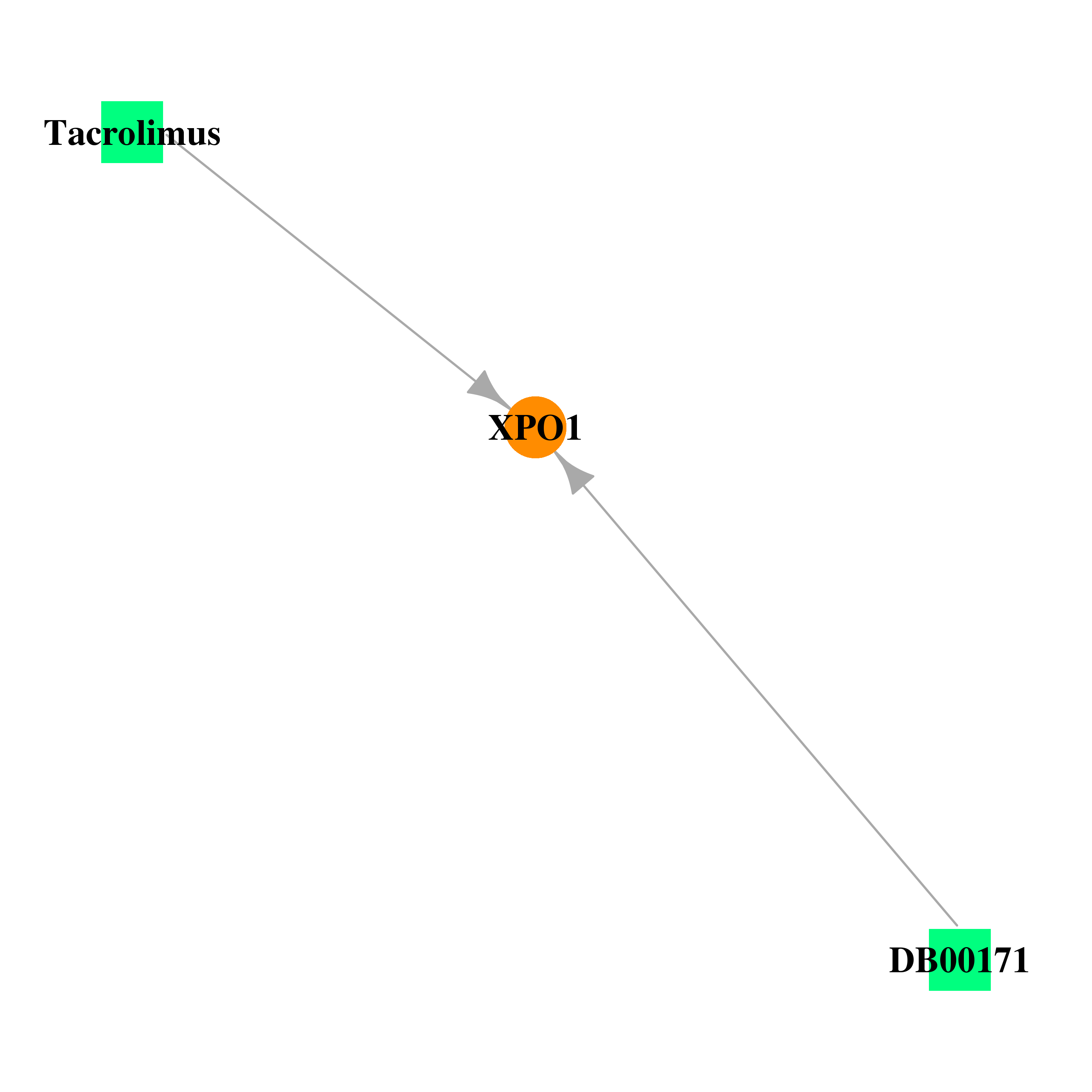 |
| * Drug Centered Interaction Network. |
| DrugBank ID | Target Name | Drug Groups | Generic Name | Drug Centered Network | Drug Structure |
| DB00171 | exportin 1 (CRM1 homolog, yeast) | approved; nutraceutical | Adenosine triphosphate |  |  |
| DB00864 | exportin 1 (CRM1 homolog, yeast) | approved; investigational | Tacrolimus |  |  |
| Top |
| Cross referenced IDs for XPO1 |
| * We obtained these cross-references from Uniprot database. It covers 150 different DBs, 18 categories. http://www.uniprot.org/help/cross_references_section |
: Open all cross reference information
|
Copyright © 2016-Present - The Univsersity of Texas Health Science Center at Houston @ |








